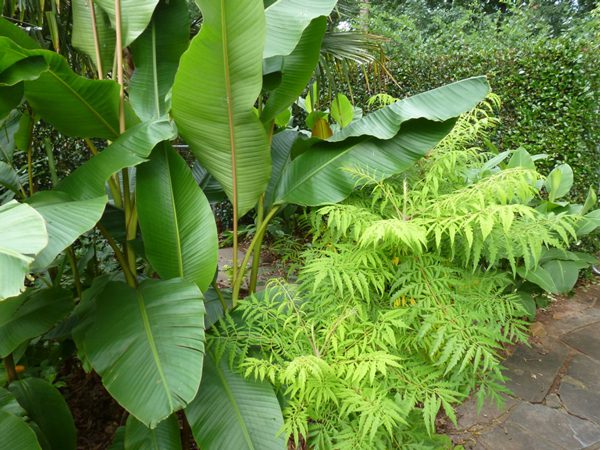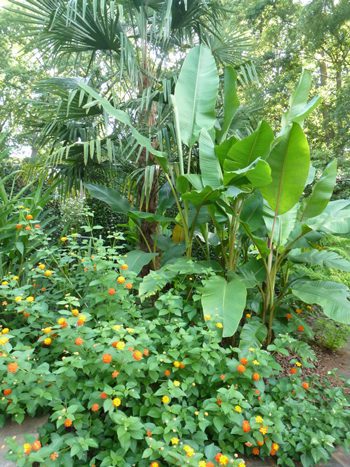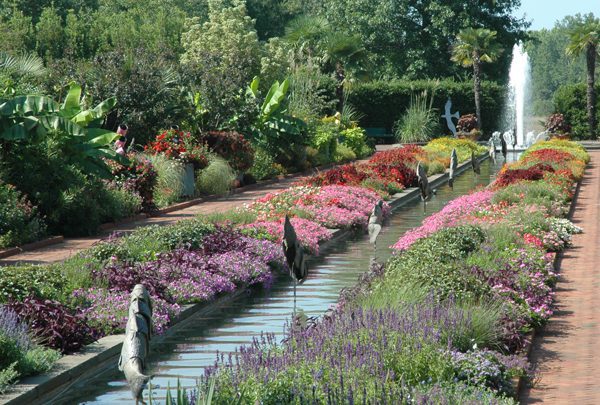A tropical garden in the temperate Piedmont

The right combination of protective hedges, sun-absorbing walls and a southern exposure can turn a corner of your yard into a tropical microclimate – especially in a rain-soaked year like this one.
Last summer’s record heat and drought gave us a taste of weather in desert regions. This year, the abundant rainfall has been more evocative of the tropics. A walk through the small pocket garden on the south side of my sister’s house in Charlotte heightens that sensation. The area is enclosed by a ligustrum hedge about the height of an NBA center. It protects the site from bitter winter winds. The brick and stone façade of her house absorbs the sun’s rays for much of the day then releases the heat at night. The flagstone walkway between the narrow beds also stores and radiates warmth. These elements combine to create a microclimate conducive to lush and leafy tropical plants.
 The garden has gone through several iterations. In the early days, it was more dependent on colorful annuals. Now that the perennials are getting established, the focus has shifted toward foliage. Her goal is to have a wall of vegetation on each side of the path. Her windmill palm is nearly ten feet tall. The banana trees are almost twice that. For the past few years, they’ve flowered and produced small, inedible fruits. Evergreen fatsias swaddle their trunks, offering an easy and aesthetically pleasing form of winter protection.
The garden has gone through several iterations. In the early days, it was more dependent on colorful annuals. Now that the perennials are getting established, the focus has shifted toward foliage. Her goal is to have a wall of vegetation on each side of the path. Her windmill palm is nearly ten feet tall. The banana trees are almost twice that. For the past few years, they’ve flowered and produced small, inedible fruits. Evergreen fatsias swaddle their trunks, offering an easy and aesthetically pleasing form of winter protection.
Cannas, ginger lilies and elephant ears are herbaceous mainstays. She has a gigantic elephant ear strategically placed beneath a low spot in the gutter. It appreciates the occasional deluge, producing leaves nearly six feet long and wide. Its blooms, she and the kids have decided, smell like chewing gum. Philodendron is typically treated as a houseplant in our region, but hers has proven winter-hardy. Hostas, gingers and cast iron plants work well in her shadier areas. The only annual she uses these days is cuphea. In the past she relied on coleus, fuchsia, impatiens and sweet potato vine to provide some punch and instant gratification.
While these plants hail from foreign lands, species native to the South can also play a role in the tropical garden. A neon cultivar of staghorn sumac brightens a corner of my sister’s garden. Asian hibiscus is often used as an annual in containers, but many of our native hibiscus are not only winter-hardy, they’re even more elegant. Lantana is generally associated with dry and sandy soils, but it looks right at home in a tropical garden and doesn’t seem to mind the extra water. In fact, some areas between the Tropic of Cancer and the Tropic of Capricorn are actually dry, so cacti, yuccas, grasses and agaves can also earn a place in a tropical garden if they are properly sited.
My sister insulates her garden with a thick blanket of leaves each fall. The mulch not only guards against extreme temperature fluctuations, it also provides nutrients for these notoriously heavy feeders – they expend a lot of energy producing all that foliage every year. Mulching also helps retain moisture during dry spells in summer. That said, these plants are apt to rot if they sit in soggy soil all winter.
The Daniel Stowe Botanical Garden (www.dsbg.org) in Belmont has one of the state’s most exciting tropical gardens. The garden’s director of horticulture, Peter Grimaldi, says the Canal Garden was always intended to be a showcase for big, bold plants in sizzling hot colors. Well over half the material is perennial. Grimaldi says these plants survive our Piedmont winters without a great deal of coddling. He offers the following tip: Let plants such as bananas, ginger lilies and elephant ears get zapped by the first hard frost and start to “melt” before cutting them back to the ground. That advice has always worked for me, but I wait until spring to cut back lantanas.
Tropical plants are used in smaller doses throughout the other gardens at Daniel Stowe. Grimaldi says they bring “splashes of informality” to some of the more traditional Southern gardens. He likes the juxtaposition of having a palm tree interrupt a staid azalea border. He thinks it reflects the flamboyant spirit of the garden’s namesake benefactor.

That observation led me to ponder how I’d describe my sister’s tropical garden. The list of adjectives that came to mind – textured, layered, understated, sturdy and serene – is also an uncanny representation of her nature. Likewise, whether it’s a mature willow oak in the background or its tiny leaves scattered on the beds, the Piedmont will inevitably find a way to express its personality in our tropical gardens.
Many thanks to Peter Grimaldi, Jim Hoffman and Tom Gardner at Daniel Stowe Botanical Garden for their assistance with this article.